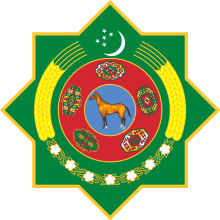Shajare-i Tarakime
Shajare-i Tarākime ("Genealogy of the Turkmens") is a historical work of the Khan of Khiva and prominent historian of the 17th century - Abu al-Ghazi Bahadur,[1] which describes the history of Turkmens since ancient times (biblical times), the birth and life of the ancient ancestor of all Turkmens and the hero of all Turks - Oghuz Khan, his campaigns to conquer various countries and regions of Eurasia, as well as the rule of the Oghuz-Turkmen khans in the Middle ages.
| Look up oğuz in Wiktionary, the free dictionary. |
About the author
Abu al-Ghazi Bahadur (or Ebulgazi Bahadir Han, 1603‒63) was the Khan of Khiva and a renowned historian of the Turkic peoples who wrote his works in Chagatai language. He was the author of two works that have great importance in learning Central Asian history, Shajare-i Tarākime or Şecere-i Terakime (Genealogy of the Turkmens), completed in 1659, and Shajare-i Turk (The Genealogy of the Turks), which he left incomplete. The second work was completed by his son, Abu al-Muzaffar Anusha Muhammad Bahadur, in 1665.[2]
Content

According to Abu al-Ghazi, " the 'Genealogy of the Turkmens' was written ""at the request of the Turkmen mullahs, sheikhs and beks"", who believed that the previous Oghuz-names were full of "errors and differences" and that it was necessary to give an official version of the legend about the origin of the Turkmens.
"'Genealogy of the Turkmens" is not only an important historical source, but also a significant literary work, which describes numerous Turkmen folk legends, tales, etymologies of ethnonyms, proverbs and sayings.
"The Genealogy of the Turkmens' can be divided into three parts: information of a biblical nature (the legend of Adam); information based on the Oghuz-Turkmen epic, which includes the legend of Oghuz and his descendants, and information acquired through oral tradition about the origin, division and location of the Oghuz tribes (in particular, the legend of Salyr), about Tamga, Ongons and others.[3]
Shajare-i Tarakime roughly follows Rashīd ad-Dīn’s already Islamized and Mongolized (post-conquest) version about the origin of Oghuz Khan and Turks (Turkmens). But in his account, Oghuz Khan is fully integrated into Islamic and Mongol traditional history. The account begins with descent from Adam to Noah, who after the flood sends his three sons to repopulate the earth: Ham was sent to Hindustan, Sam to Iran, and Yafes was sent to the banks of the Itil and Yaik rivers. Yafes had eight sons named Turk, Khazar, Saqlab, Rus, Ming, Chin, Kemeri, and Tarikh. As he was dying, he established Turk as his successor.
Tribal organization
According to the "Genealogy of the Turkmens", Oghuz Khan had six sons in total, and each of them in turn had 4 sons from their eldest (first) wives and several more from their other wives. Twenty-four grandsons from the eldest wives of the sons of Oghuz Khan were the ancestors of the 24 oldest and main Oghuz-Turkmen tribes and the heads of the so-called "Aimak". Each of the main 24 tribes was joined by other tribes whose ancestors were the grandsons of Oghuz Khan from the secondary wives of his sons and so on: this is the main association of several clans that formed a single "Aimak".
Two united Aimaks formed "yuzluks". The yuzluks, in turn, were grouped into two main groups:" Bozok (senior tribe) and Uchok (junior tribe). Thus, the entire ancient Oghuz-Turkmen people were divided into two parts (Bozok and Uchok): each of these parts was divided into 12 yuzluks, and each of the yuzluks was divided into two Aimaks.[4]
24 Oghuz tribes according to the Genealogy of the Turkmens by Abu al-Ghazi Bahadur:
Bozoks (Gray Arrows)
- Gün Han
- Kayı (Ottomans[5] and Jandarids)
- Bayat (Qajars, Dulkadirids, Fuzûlî)
- Alkaevli
- Karaevli
- Ay Han
- Yazır
- Döger (Artuqids)
- Dodurga
- Yaparlı
- Yyldyz Han
- Afshar (Afsharids and Zengids)
- Kızık
- Begdili (Khwarazmian dynasty )
- Kargın
Üçoks (Three Arrows)
- Gök Han
- Dag Han
- Salur (Kadi Burhan al-Din, Salghurids and Karamanids; see also: Salars)
- Eymür
- Alayuntlu
- Yüreğir (Ramadanids)
- Dengiz Han
- Iğdır[7]
- Büğdüz
- Yıva (Qara Qoyunlu and Oghuz Yabgu State)
- Kınık (founders of the Seljuk Empire)[8]
References
- Chahryar Adle, Irfan Habib (2003). History of civilizations of Central Asia (Volume V ed.). Paris: UNESCO Publishing. p. 133. ISBN 92-3-103876-1.
- "The Genealogical History of the Tartars, Translated into French from the Tartar Manuscript Written in the Mughal Language by Abu al-Ghazi Bahadur, Khan of Khowarazm, Supplemented by a Large Number of Reliable and Curious Notes on the Present State of Northern Asia with the Requisite Geographic Maps and from French into Russian at the Academy of Sciences". World Digital Library.
- Kononov А. Н. (1958). "Genealogy of the Turkmens. Introduction (in Russian)". M. AS USSR.
- O. Tumanovich (1926). "Turkmenistan and Turkmens". World digital library. Turkmen state publishing house, Ashgabat, Turkmenistan.
- "Some Ottoman genealogies claim, perhaps fancifully, descent from Kayı.", Carter Vaughn Findley, The Turks in World History, pp. 50, 2005, Oxford University Press
- Oğuzlar, Oğuz Türkleri
- IGDIR
- Kafesoğlu, İbrahim. Türk Milli Kültürü. Türk Kültürünü Araştırma Enstitüsü, 1977. page 134
Further reading
- E. G. Ambros, P. A. Andrews, Ç. Balım, L. Bazin, J. Cler, P. B. Golden, A. Gökalp, B. Flemming, G. Hazai, A. T. Karamustafa, S. Kleinmichel, P. Zieme, E. J. Zürcher; Artikel Turks, Encyclopaedia of Islam, Digital Edition, The Tribal History Of The Central Asian Turks.
- Mahmud al-Kashgari; "Dīwān Lughāt al-Turk".
- Golden, Peter; Bosworth, C. Edmund (2002). "ḠOZZ". Encyclopaedia Iranica, Vol. XI, Fasc. 2. pp. 184–187.CS1 maint: ref=harv (link)
- Golden, Peter B. (2020). "Oghuz". In Fleet, Kate; Krämer, Gudrun; Matringe, Denis; Nawas, John; Rowson, Everett (eds.). Encyclopaedia of Islam, THREE. Brill Online. ISSN 1873-9830.
See also
- Oghuz Turks
- Turkic peoples
- Turkmens
- Dede Korkut
- Khanate of Khiva

